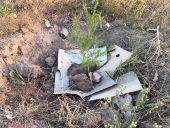The store people and even some landscapers will tell you that you need to buy garden soil if you're going to put in a garden. They'll tell you to buy more every year. When I was first starting out, that's what I did, until I learned, via experience, it's a scam.
No, really, it is. I grow things better in fill dirt subsoil than in that plastic-bagged garbage from the store. Yes, it is garbage. Tree trimmer wood chips, composted sewage sludge, animal waste, etc. Not that those don't make good fertilizers, but the ratios those bags have are often strongly wood chips, which means any fertilizer in the bag is tied up decomposing the wood chips, and not feeding your plants.
Those that aren't high in wood chips will feel like a solid mud clod, because they are. Live soil is full of-well- life. You take that away, shove it in a mostly non-breadthing plastic bag and mush it on a pallet and it dies. It's then just compacted dirt. It maybe mostly organic matter compacted dirt, but it's not healthy soil.
Because it's not healthy soil, the microbes in the soil which help plants grow vs. The ones that decompose stuff is in favor of decomposition. Which means your microbes will be working against you until they re-balance to your garden. This means your plants are more likely to get sick, which means more pests.
Think that's bad enough? There's more: weeds and decomposition. Yes, they can carry weed seed. So while you carefully weed everything from your garden, you then apply soil which brings them back. Joy.
It's the end of the season. You completed a season with adding fertilizer to your garden soil, staving off disease and pests, and weeding the plants it brought in. What else could go wrong? As you admire your garden, you notice that it looks a little low in soil. Want to know why? The store bought soils are mostly organic matter, which means when they are fully decomposed, they leave your garden bed via volatilization or in your plants. The wood chip type do this more than the mud clod type because the wood chips decompose taking up less space. What you have at the end ofthe season is more work and money to refill your bed of magic disapearing soil.
I switched to using subsoil, some peat moss, organic matter on hand,
compost, organic fertilizer, and time. Subsoil is full of micronutrients, a strong matrix of stuff (no need to discuss soil chemistry) that doesn't magically disappear in in a year and allows natural air pockets to develop, it's usually local which means the local microbes are adapted to it. What it lacks to kick into real good soil can be developed in 3 years by adding 4 things:
Organic fertilizer (this mimics naturally decomposed stuff and animal poo that would be in a healthy soil. I apply liberally as the plants need it.
Compost from your yard. This adds local microbes and places to live without bringing in new weeds. It doesn't need to be fully decomposed. Healthy soil isn't fully composted, it's always got some of both.
Organic matter on hand. This is to draw the worms in and get them making air holes and work their magic.
Peat is local here. It's another food and ratio thing to get the ecology kick started. If I had lots of compost, I may leave this out. It's not weedy, so since I have to buy some decomposed organic matter, I buy this. Even still, I only add a little, just to help compensate for our high in clay and very low in organic matter subsoil.
Time. The first year I imagine the plants are sort of hydroponic. They get about all their food from what I add via fertilizer. They may need more water too. I don't expect high yields. I mostly want them to be edible cover crops. Year two I still give them more fertilizer, but the yields increase. The soil is still a little rough, but the yields are about what you'd get in a normal garden. Year three I get my neighbors asking for advice because not only am I getting higher yields, but I am also not schlepping bags of soil, dealing with much pest, or doing much weeding. True story.








